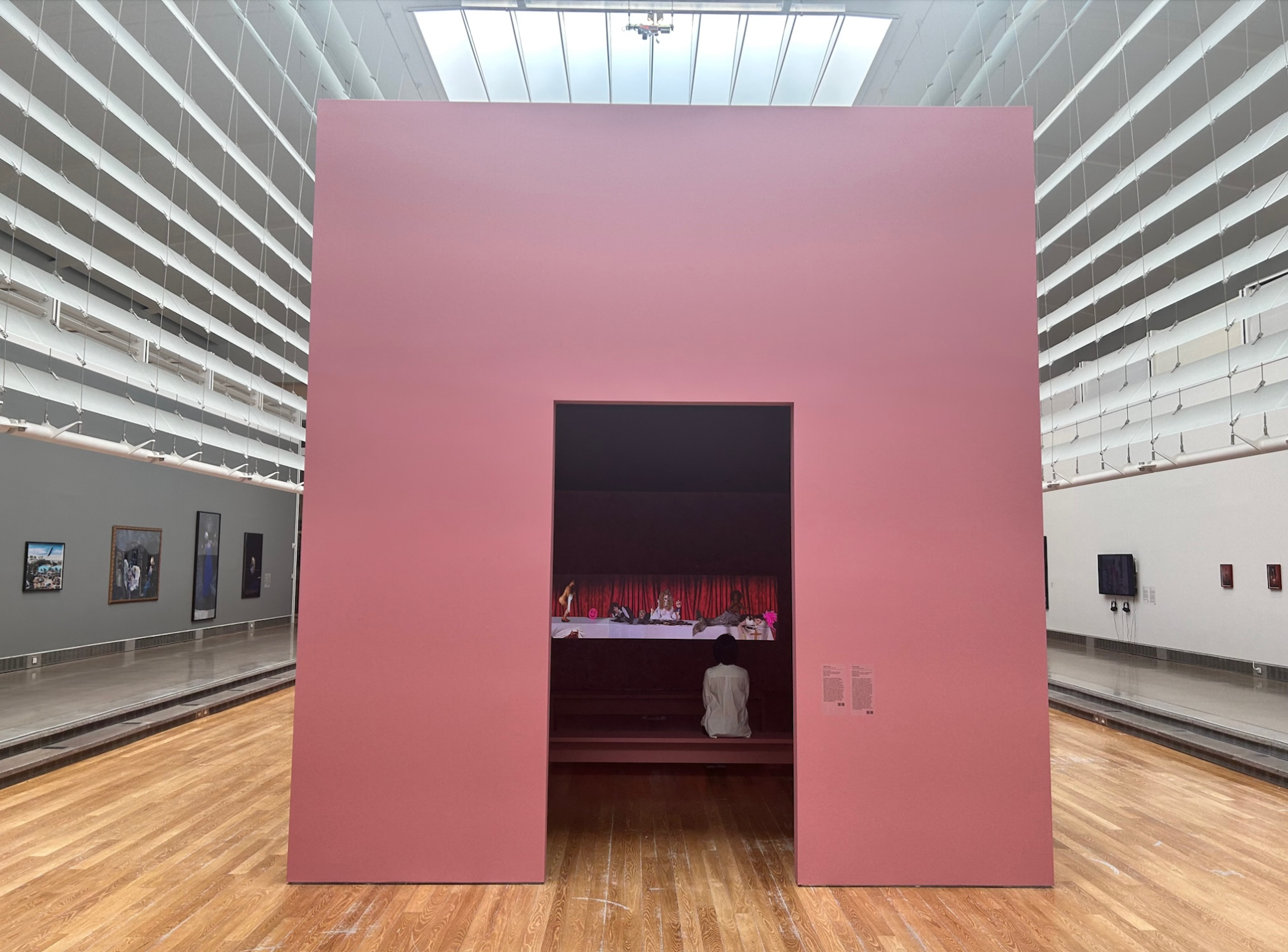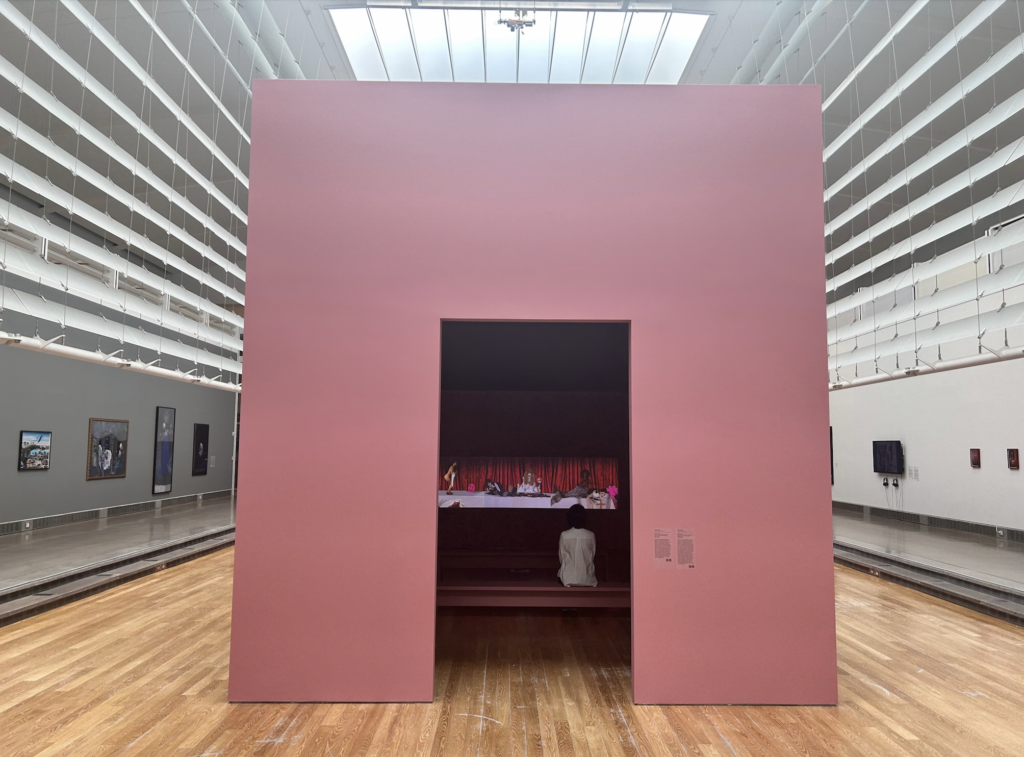
Earlier this week, Brooklyn-based artist Xaveria Simmons accused the Queens Museum in an Instagram post of “institutional and curatorial negligence” after the museum repurposed a sculptural work by the artist for a later exhibition.
In October 2022, the Queens Museum opened an exhibition by Simmons, with the text-based installation piece, Align, as its centerpiece. Titled “Crisis Makes a Book Club,” the exhibition included a series of new works by Simmons that spanned photography, video, text, and sculpture, all of which touched on issues of race and class in the US.
Erected in the atrium of the museum’s main floor, Align stood as a large-scale, black-walled structure measuring 16 feet high and 15 feet in length and covered in all-caps, white lettering. The text drew from an essay by James Baldwin and referenced “white privilege” and “allies.” The piece resembled a free-standing gallery, and it included an entrance on one side that lead into an interior space. Painted mustard yellow, the enclosure served as a space of respite where visitors could sit and watch a video work by Simmons.
When the show came down in March, unbeknownst to Simmons, the museum staff retained the structural elements of Align to use it as a temporary gallery space to show works for one of its next exhibitions. Painted over in pink, the structure displayed photographs and videos for a survey of works by Tracey Rose that had traveled from the Zeitz Museum of Contemporary Art Africa in Cape Town and marked the artist’s first major US museum survey.
In an interview this week, Simmons told ARTnews, that when the museum repurposed Align, it had done so without her consent and violated their initial loan agreement. Simmons has described Align as an architectural intervention in the museum, and she said she conceptualized it to be mounted in a specific rectangular form using dimensions that were meant to be distinct to the work itself.
In a statement to ARTnews, a representative for the Queen Museum said it was “common practice for museums to repurpose portions of an exhibit” and that they were “grateful” to the artist describing her exhibition as “bold and brilliant.” The Queens Museum did not respond to questions regarding the terms of the loan agreement.
But, according to Simmons, when the exhibition closed in March, Simmons and the museum’s curatorial staff agreed that the architectural support that filled its atrium space, and on which the panels featuring her hand-painted text pieces were adhered, would be dismantled and returned to her studio in Brooklyn. “The conceptual framework, the architecture was all of my work,” Simmons said.
Simmons said the museum’s reuse of Align’s “footprint” as a host for photographic work by another artist without her knowledge violated her authorship. She said the decision by the curatorial staff to use the interior space she conceptualized specifically for Align to host works by Rose allowed them to effectively apply her conceptual framework to the work of the South African performance artist.
Simmons told ARTnews that the concept of the piece was meant to deliver an “imagined response” from a theoretical group of predominantly white cultural philanthropists and arts professionals to a period of racial reckoning in the US between 2020 and 2022. In order to produce it, Simmons worked with the museum’s preparators and raised outside funding for the showcase from private collectors and her Miami-based dealer David Castillo. In total, the exhibition’s fundraising amounted to $330,000 with expenses totaling $344,000 — its most expensive exhibition to date, according to a Queens museum representative. After the Queens Museum show was mounted, Align received widespread recognition for its messaging. (ARTnews ranked it as one of the defining works of 2022.)
Around the time the show was being deinstalled, Simmons had believed Align would be returned in its entirety, both the panels mounted to the structure and the structure itself. In an email dated March 17, around two weeks after the exhibition’s closing on March 5, Lynn Maliszewski, the museum’s assistant director of archives and collections, sent a group of condition reports related to the individual works that had been shown in “Crisis Makes a Book Club” that were to be returned to Simmons’s studio. A group of photographs, alongside “all panels from Align” would be returned, according to Maliszewski’s email, which was reviewed by ARTnews. Simmons believed this to mean the entire work would be returned, as stipulated in the artist’s loan agreement with the museum. By mid-March, according to the artist, only the text-based panels from “Align” had been returned to her studio. (They were placed in storage due to their scale.)
In April, the museum contacted Simmons to inform her that the remaining structure of the piece had been repurposed for Rose’s show. In an email dated on April 20, Linsey Berfond, an assistant curator at the Queens Museum who worked on Simmons’s exhibition, told Simmons that the work’s structural support had been reused as a “host” to Rose’s work. “We were able to renovate the freestanding structure/enclosed gallery space in the atrium into a new configuration (with an entrance on the opposite side, drywall exterior, and the inside turning a screening room for a single video),” Berfond wrote in her email, which was reviewed by ARTnews. “This adds less to the landfills, win-win!”
In a letter addressed to the museum’s board of directors and dated on April 22, Simmons wrote: “I have been made aware that the Queens Museum executive and curatorial staff have used my work to anchor another artist’s work without my consent, consultation, or permission.” In the letter, Simmons went on to describe the work as a “site-specific sculptural work and site-specific installation that I believed to have been taken down in its entirety after my exhibition closed.” She went on to describe the museum’s repurposing of the materials and its structure as an “infringement” on her “work and labor.”
Her letter continued, “I am taken aback and aghast. Having shown in major institutions in the United States and abroad, no institution has ever repurposed my work for another artist. This is a very unfortunate first in my career.”
On April 23, the museum’s executive director Sally Tallant reached out to Simmons to try to rectify the issue. In a call, the two agreed that the work, at Simmons’s request, be immediately removed and its materials be disposed of. Images of the destruction of the work would be photographed for Simmons’s studio to use as archival records. Simmons also requested that the structure’s “footprint” not be duplicated for future use. The museum agreed to the requests, temporarily closing the Rose exhibition in early May in order to take the structure down and build a replacement.
When Simmons reached out to the museum for an update about the dismantling process, Maliszewski, the assistant director, wrote on April 27, “I have no comments to share on the status of these temporary walls.”
On May 3, Simmons penned a second letter to the museum’s board regarding the status of the work’s dismantling, describing the experience as “unsettling and appalling.” On the same day, Tallant confirmed over email to Simmons that the work’s structural elements had been disposed of. She sent a group of images of the work’s metal infrastructure appearing in garbage bins, writing: “Please find attached photos of the dismantled structure that supported your work as agreed.” (Simmons did not receive responses from board members to either letter.)
In response to detailed inquiries by ARTnews about the situation, a representative for the museum further described the museum’s exhibition space as limited. “They have built temporary pavilions as a way to mitigate this in the past,” adding, the reuse of materials from Align “was not to undermine the site-specificity” of the work.
“I never imagined they would have me do this labor of producing a work, conceptualizing the architecture with preparators and then keep that object after the show came down,” Simmons said. She questioned whether the museum would have repurposed the structure if the work had been associated with an artist like Donald Judd or Joseph Beuys, noting that their practices have each been canonized for their site-specific approaches.
Simmons added, “What made it so comfortable?”


